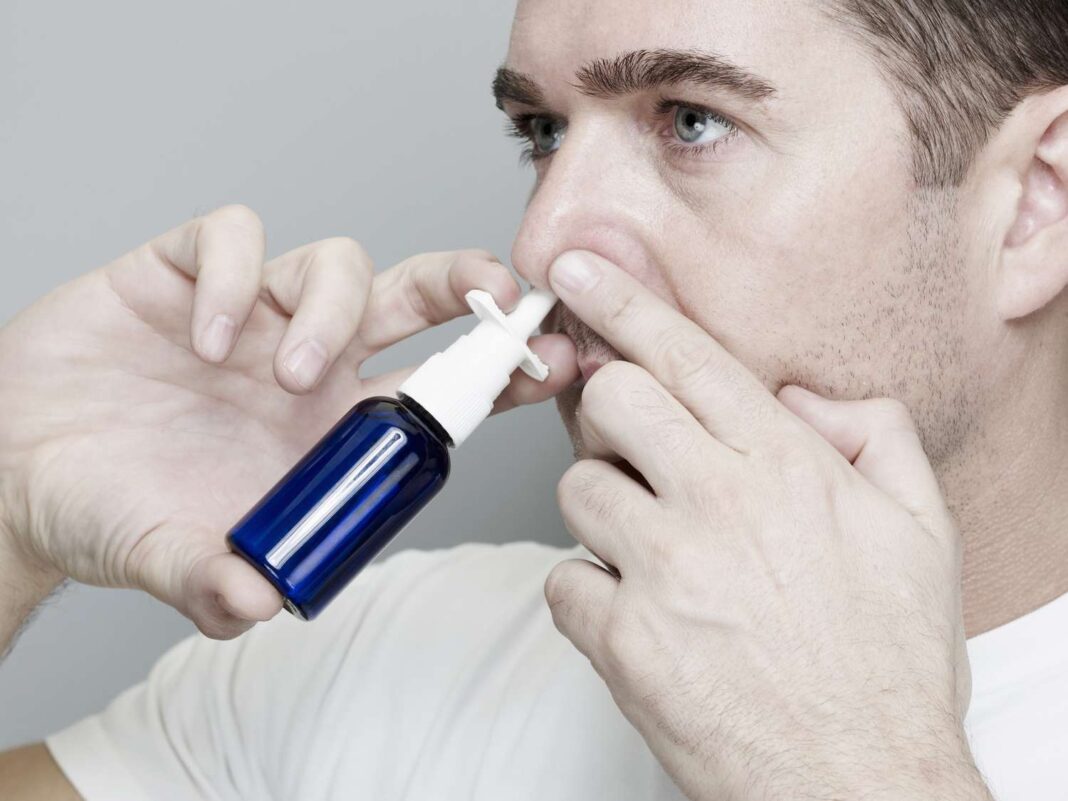OTC Cold and Allergy Nasal Sprays
OTC Cold and Allergy Nasal Sprays
| Brand | Generic Name | Description |
|---|---|---|
| Afrin | Oxymetazoline | Relieves nasal congestion from colds and sinus problems |
| NasalCrom | Cromolyn | Relieves and prevents symptoms of allergic rhinitis such as sneezing, runny nose, or itching |
| Neo-Synephrine | Phenylephrine | Relieves nasal congestion from colds and sinus problems |
| Flonase | Fluticasone Propionate | Treats sneezing and symptoms of hay fever |
| Nasacort | Triamcinolone | Treats an itchy or runny nose |
| Rhinocort | Budesonide | Steroid medication that prevents inflammation and treats a runny and itchy nose |
| Xhance | Fluticasone | Prescribed to treat nasal polyps |
Can I Use OTC Nasal Sprays for COVID?
If you have COVID-19 and have nasal symptoms like congestion and sneezing, you might wonder if a medicated nasal spray would be helpful. Researchers are still looking into this and whether these sprays are safe for people with COVID.
One study in 2021 found that people who were already using steroid nasal sprays before they got COVID didn’t get as sick as people who weren’t using them. However, the researchers did not think there was enough evidence to support nasal sprays as a treatment for COVID or as a way to prevent COVID.
If you have COVID and are looking for relief from nasal congestion and other symptoms, ask your provider if you can use an OTC nasal spray or if they can prescribe one for you.
Prescription Allergy Nasal Sprays
- Astelin (Azelastine): A steroid-free antihistamine that reduces nasal allergy symptoms, such as a runny nose, hay fever, or other allergies (also available OTC in the U.S. under the name Astepro Allergy for adults and children ages 6 years and older)
- Nasarel (flunisolide): Relieves allergy symptoms, such as a runny or stuffy nose; sneezing, and itching (now available only as a generic)
- Nasonex (mometasone): Shrinks nasal polyps and prevents and treats stuffy nose and other allergy symptoms
- QNASL (beclomethasone): Treats allergy symptoms, such as sneezing
- Zetonna/Omnaris (ciclesonide): Treats itchy and runny nose, and sneezing
- Xhance (fluticasone): Prescribed to treat nasal polyps
- Dymista (fluticasone/azelastine combination): Treats allergy symptoms, such as a runny and itchy nose
- Patanase (olopatadine): Treats allergy symptoms, such as itchy nose and eyes
Other Types of Nasal Sprays
- Calcitonin: Treatment for osteoporosis that controls the amount of calcium in the body and helps maintain proper bone density
- Imitrex (sumatriptan): Relieves attacks of migraine with or without an aura
- Nicotine nasal sprays: Smoking-cessation device
- FluMist: Intranasal influenza vaccine that could only be given by a healthcare professional, but was recently approved for at-home administration
How to Use Nasal Spray
Instructions on how to use a nasal spray differ somewhat depending on the type of spray. If you don’t understand the instructions for the product you’re using, ask your pharmacist to walk you through them.
Before using a nasal spray:
- Make sure you can breathe through each nostril
- Know that some nasal sprays need to be primed before use
- Store your nasal spray as directed
- Keep the bottle away from direct sunlight
- Don’t share your nasal spray with other people
- Keep nasal sprays where children cannot reach them
Step-by-Step Nasal Spray Instructions
- Blow your nose gently to remove mucus from your nasal passages.
- Wash your hands with soap and water.
- Gently shake the bottle of nasal spray and remove the cap. If needed, prime the dispenser before using it.
- Tilt your head slightly forward.
- Close one nostril by gently pressing against the side of your nose with your finger.
- Insert the tip of the nasal spray into the other nostril.
- Point the tip toward the back and outer side of your nose. Make sure to direct the spray straight back, not up into the tip of your nose.
- Squeeze the nasal spray bottle as you slowly breathe in through your nose.
- Remove the tip of the nasal spray from your nostril and breathe out through your mouth.
- Repeat these steps for your other nostril (if advised). Follow the directions and use only the recommended amount of medication.
- Wipe the tip of the nasal spray with a tissue or alcohol pad and put the cap back on.
- Try to avoid sneezing or blowing your nose after using the nasal spray.
Conclusion
Nasal sprays are a common treatment for various nasal symptoms, including congestion, allergies, and sinus infections. There are many types of nasal sprays available, including over-the-counter (OTC) and prescription medications. Before using a nasal spray, make sure to read and follow the instructions carefully. If you have any questions or concerns, consult with your healthcare provider.
FAQs
Q: Can I use OTC nasal sprays for COVID-19?
A: Researchers are still looking into this, and there is currently no evidence to support nasal sprays as a treatment for COVID-19.
Q: What are some common side effects of nasal sprays?
A: Common side effects of nasal sprays include nosebleeds, sinus pressure, and headaches.
Q: How do I know which nasal spray is right for me?
A: Consult with your healthcare provider to determine which nasal spray is best for your specific symptoms and needs.
Q: Can I use nasal sprays if I have a cold or sinus infection?
A: Yes, nasal sprays can be used to relieve congestion and other symptoms associated with colds and sinus infections. However, always follow the instructions and consult with your healthcare provider if you have any questions or concerns.




